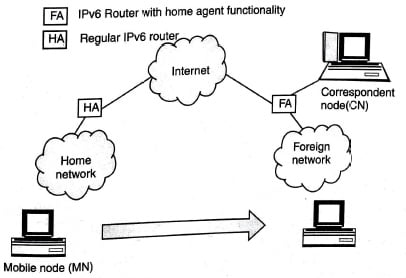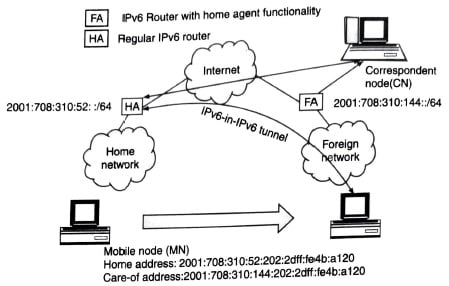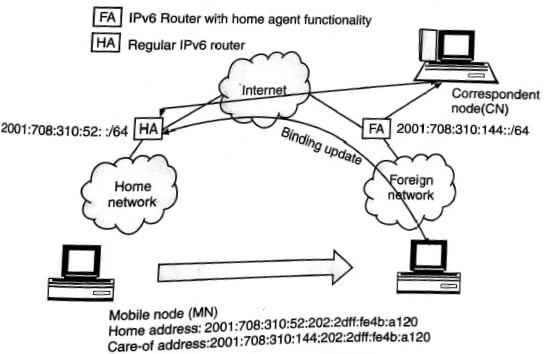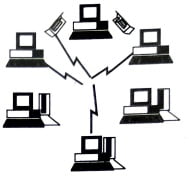Table of Contents
Mobile Internet Protocol (or Mobile IP)
Mobile Internet Protocol (or Mobile IP) is the underlying technology for the support of various mobile data and wireless networking applications. With the advent of packet-based mobile data applications and the increase of wireless computing, there is a corresponding need for the ability for seamless communication between the mobile node device and the packet data network (PDN) such as the Internet.
As PDAs and the next generation of data-ready cellular phones become more widely deployed, a greater degree of connectivity is almost becoming a necessity for the business user on the go.
Data connectivity solutions for this group of users are a very different requirement than it is for the fixed dialup user or the stationary-wired LAN user. Solutions here need to deal with the challenge of movement during a data session or conversation.
Cellular service providers and network administrators wanting to deploy wireless LAN technologies need to have a solution, which will grant this greater freedom.
Terms Used In Mobile Internet Protocol (or Mobile IP)
- Agent Advertisement: An advertisement message constructed by attaching a special Extension to a router advertisement message.
- Binding: The association of the home address of a Mobile Node with a care-of address for that Mobile Node, along with the remaining lifetime of that association.
- Care-of address: An IP address associated with a Mobile Node while visiting a foreign link; the subnet prefix of this IP address is a foreign subnet prefix. Among the multiple care-of addresses that a Mobile Node may have at a time (e.g., with different subnet prefixes), the one registered with the Mobile Node’s Home Agent is called its primary care-of address.
- Correspondent Node: A peer with which a Mobile Node is communicating. A correspondent node may be either mobile or stationary.
- Foreign agent: A router on a Mobile Node’s visited network, which co-operates with the Home Agent to complete the delivery of datagrams to the Mobile Node while it is away from home.
- Foreign network: Any network other than the Mobile Node’s Home Network.
- Foreign subnet prefix: Any IP subnet prefix other than the Mobile Node’s home subnet prefix.
- Foreign link: Any link other than the Mobile Node’s home link.
- Home address: An IP address that is assigned for an extended period of time to a Mobile Node. It remains unchanged regardless of where the node is attached to the Internet.
- Home network: A network, possibly virtual, is having a network prefix matching that of a Mobile Node’s home address. Note that standard IP routing mechanisms will deliver datagrams destined to a Mobile Node’s Home Address to the Mobile Node’s Home Network.
- Home address: An IP address assigned to a Mobile Node within its home link.
- Home link: The link on which a Mobile Node’s home subnet prefix is defined. Standard IP routing mechanisms will deliver packets destined for a Mobile Node’s home address to its home link.
- Home agent: A router on a Mobile Node’s home link with which the Mobile Node has registered its current care-of address. While the Mobile Node is away from home, the Home Agent intercepts packets on the home link destined to the Mobile Node’s address, encapsulates them, and tunnels them to the Mobile Node’s registered care-of address.
- Host: Any node that is not a router.
- Mobile node: A node that can change its point of attachment from one link to another, while still being reachable via its home address.
- Movement: A change in a Mobile Node’s point of attachment to the Internet such that it is no longer connected to the same link as it was previously. If a Mobile Node is not currently attached to its home link, the Mobile Node is said to be away from home.
- Tunnel: The path followed by a datagram while it is encapsulated. The model is that, while it is encapsulated, a datagram is routed to a knowledgeable decapsulating agent, which decapsulates the datagram and then correctly delivers it to its ultimate destination.
Mobile IP Routing Operation
- To accomplish this, mobile IP established the visited network as a foreign node and the home network as the home node.
- Mobile Internet Protocol (or Mobile IP) uses a tunneling protocol to allow messages from the PDN to be directed to the mobile node’s IP address. This is accomplished by way of routing messages to the foreign node for delivery via tunneling the original IP address inside a packet destined for the temporary IP address assigned to the mobile node by the foreign node.
- The Home Agent and Foreign Agent continuously advertise their services on the network through an Agent Discovery process, enabling the Home Agent to recognize when a new Foreign Agent is acquired and allowing the Mobile Node to register a new Care-of Address.
- This method allows for seamless communications between the mobile node and applications residing on the PDN, allowing for seamless, always-on connectivity for mobile data applications and wireless computing.
- The mobile node is a host equipped with a Mobile IPv6 stack the correspondent node can be a host with a regular IPv6 stack but in this case, we assume it has a Mobile-IPv6 stack.
- Home Agent is the register for mobile terminals. Terminals register the care-of-addresses (i.e. where they really are today) to the home agent.
- Unlike in Mobile IPv4, in Mobile IPv6, there are not foreign agents in the foreign network, just the IPv6 router.
- Design requirements for Mobile IP:
- Detection: the mobile node must detect it has moved.
- Address Configuration: the mobile node must discover or configure its care-of-address.
- Binding Update: the mobile node must inform the home agent about its new care-of address.
- Tunneling: the home agent must forward packets from the home network to the mobile node’s care-of address.

Functionality in the Home Network
- The home router sends router advertisements.
- The mobile node receives its home address from the home network via neighbor discovery protocol.
- The mobile node can listen to the Router Advertisements (ICMPv6) or it can send Router Solicitation request to get or ensure the network prefix.
- The mobile node starts for example a video call with a correspondent node; the line signifies the route of the traffic.

Moving to Foreign Network
- When moving to the foreign network, the mobile node is unreachable depending on how long it takes to get IPv6 connectivity again.
- The traffic between a mobile node and the correspondent node is stalled.
- The home agent may know that the mobile node has already left the network and can for example buffer some of the traffic coming destined to the mobile node.
- There is a lot of research going on which purpose is to minimize the handover/configuration time so that this delay would be minimal.
- It is recommended that mobile nodes use lower-layer mechanisms for detecting the movement, for example, the signal/noise level/ratio in WLAN to detect movement.
- Router Solicitation message to get an answer from the routers in the foreign network. If the detection on lower levels is not possible, then there are mechanisms in RFC2461 for movement detection. For example, listening to new different router advertisements.
- After entering the foreign network and possibly sending the Router.
- Solicitation message, the mobile node receives a new network prefix from the foreign network’s routers and constructs a new address for itself called Care-of-Address.

Functionality in the Foreign Network
- In the foreign network, we have regular IPv6 router sending Router Advertisements with the foreign network’s network prefix.
- Now, also the mobile node has auto configured its new care-of-address.
- The mobile node must discover or configure its care-of-address.
- The mobile node must inform the home agent about its new care-of address.
- Sending a message containing the mobile node’s new Care-Of-Address and Mobile Node’s authentication information does informing the home agent. This message is called binding update.
- The home agent that maintains the register of mobile node care-of-addresses and home addresses now updates its Binding Cache according to the mobile node’s message.
- Tunneling: the home agent must forward packets from the home network to the mobile node’s care-of address.
- After the Binding Update, the Home Agent knows the mobile node’s new care of address and is able to tunnel the packets in the IPv6-in-IPv6 tunnel to the mobile node.

Home Agent’s work items
- Capturing packets that are addressed to the mobile node’s home address.
- Participating in Duplicate Address Detection to protect the mobile node’s addresses on the home network against reallocation to another network node.
- Redirecting the packets that it captures when they are forwarded to the home address.
- Other tasks to inform the mobile node about renumbering events on the home network.
- This way the traffic from the Correspondent Node reaches the mobile node. The Correspondent Node still thinks that it is communicating with the mobile node that is in its home network and because of that all traffic goes through the home agent and tunneling before reaching the mobile node.
- This kind of behavior is not very effective when the Correspondent Node and Mobile Node are closer together than the home network= Route Optimization is needed.
Mobile IP Route Optimization
- Binding Update to the Rescue, now the mobile node recycles the idea of binding update and sends Binding Update to the Correspondent Node that verifies it (key exchange protocols once again).
- Once verified the Correspondent Node does not need to send Binding Update Acknowledgement to Mobile Node, instead it just creates an IPv6-in-IPv6 tunnel to the mobile node’s Care-of-Address and redirects the traffic to the tunnel.
- The advantages of this kind of route optimization are:
- Reduces network utilization, since fewer links are traversed. This could mean much less congestion in all the routing fabric of the Internet.
- Reduces the load on the home agent, and the potential for complete isolation of the mobile node due to loss of the home agent.
- Reduced round-trip times for application endpoints.
- Better predictability of routing paths, which could be crucial for QoS Management.
- More symmetric delay characteristics for incoming and outgoing traffic between mobile node and correspondent node.

Limitations of Mobile IP
- It is important to realize that Mobile IP has certain limitations in its usefulness in a wireless environments. It was designed to handle the mobility of devices, but only relatively infrequent mobility. This is due to the work involved with each change.
- This overhead is not a big deal when you move a computer once a week, a day, or even an hour. It can be an issue for real-time mobility such as roaming in a wireless network where hand-off functions operating at the data link layer may be more suitable.
- Mobile IP was designed under the specific assumption that the attachment point would not change more than once per second.
- It should also point out that Mobile IP is intended to be used with devices that maintain a static IP configuration.
- Since the device needs to be able to always know the identity of its home network a normal IP address, it is much more difficult to use it with a device that obtains an I address dynamically, using something like DHCP.
